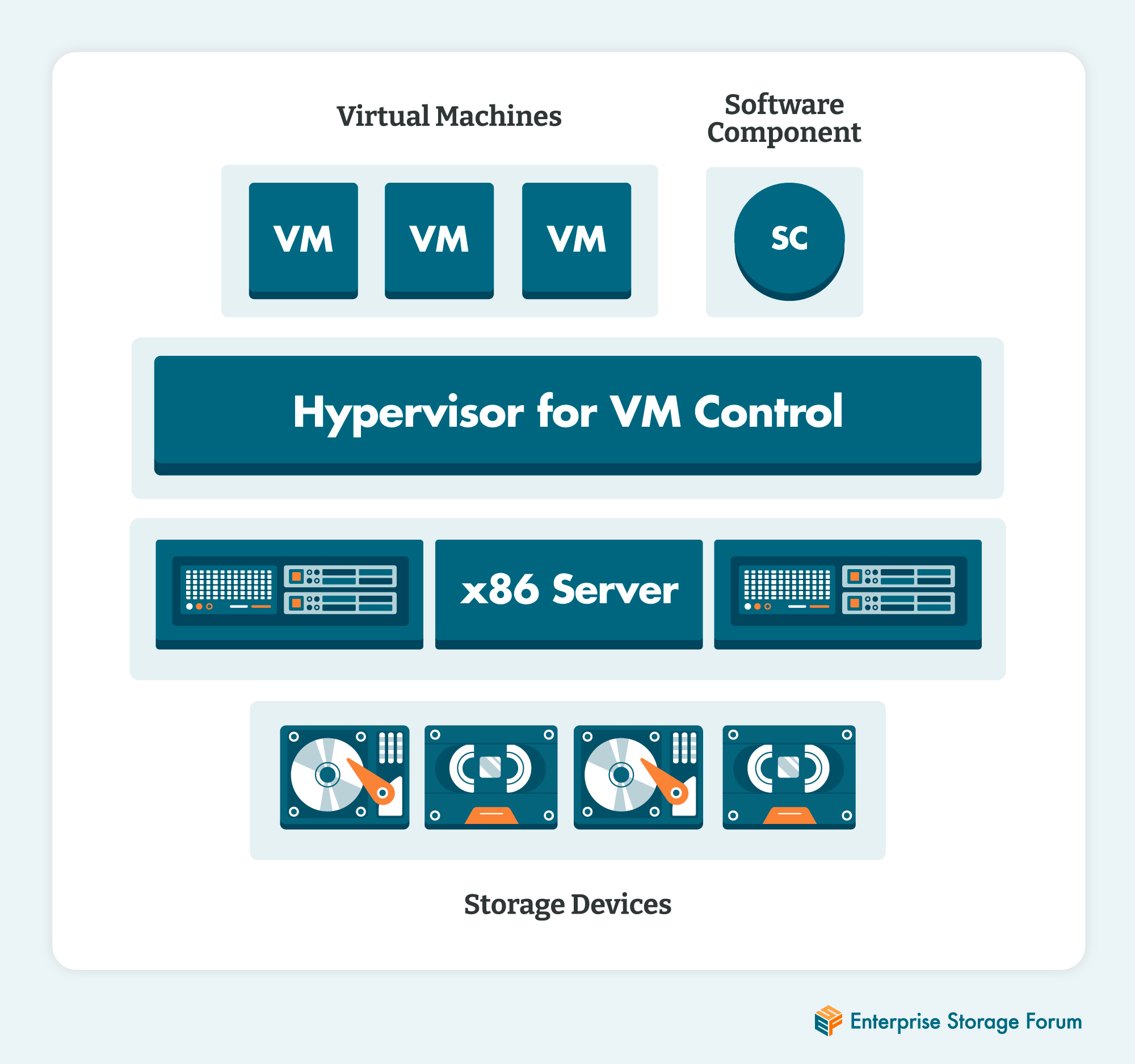A Virtual Storage Area Network (VSAN) is a virtualized storage network that allows multiple servers to access a shared pool of storage resources. Learn about VSANs and how they work.


A virtual storage area network, or vSAN, is a storage area network with a layer of abstraction between the physical hardware and the software that runs it. Traditional SANs connect physical storage devices to a standalone network—users save and access data as if the drives were local, or connected directly to their computers, allowing for a more centralized approach to data storage. In a vSAN, the storage related operations are abstracted from the actual physical storage using virtualization, allowing for more flexible, scalable, and cost-effective data storage.
Virtual storage area networks work by bringing together all of the traditional hardware components found in a data center into a virtualized appliance controlled by software. That software might be an application running on a virtual machine (VM) or rolled up with a storage vendor’s firmware and sold as a consolidated solution. vSAN architecture includes several key components essential to the functioning of the technology:

vSANS facilitate two pivotal processes: data writing/reading, and redundancy/failover management. When data is written into the system, the vSAN distributes it across multiple nodes within the entry cluster to avoid any singular point of failure. This prevents data loss and ensures business continuity by not relying on a lone node for access. On the other end, the vSAN fetches and presents data as if it comes from a single source, even if it resides on different nodes.
vSANs have inherent mechanisms to validate redundancy and fault tolerance. In the event of a node failure, they autonomously redistribute data among remaining viable nodes, maintaining persistent data availability and mitigating corruption or data loss.
This procedure is guided by the operational protocols put into place by network admins to ensure a streamlined and resilient storage management solution that meets the standards of the organization.
vSANs have gained popularity even among the many storage solutions aimed at organizations dealing with large volumes of moving and at-rest data. Here are the most common benefits they offer over traditional storage solutions.
vSANs provide exceptional scalability and flexibility, as they can be easily expanded on-demand without needing to uproot the entirety of the architecture and start from scratch. Eliminating downtime and disruptions of operations, they can also be adjusted in structure to meet changing demands, depending on low or high data flow.
The use of nodes and clusters helps reduce bottlenecks that typically occur in traditional storage systems when handling large volumes of moving data. By spreading data across multiple nodes, the data can be accessed more quickly, improving overall performance. vSANs are also optimized for modern applications, including virtualization and cloud-based solutions, ensuring smooth and efficient operations.
Thanks to optimal resource use, vSAN solutions tend to be more cost-effective and affordable than many traditional alternatives. They eliminate the need for expensive proprietary hardware often associated with storage solutions and are typically low-maintenance, requiring minimal operational costs.
Despite the benefits of using a virtual storage area network, there are challenges to take into account before considering whether the technology may or may not be a good fit. Here are the most common.
While relatively simple for an experienced professional to manage and maintain, vSANs can challenge administrators shifting from traditional storage systems. The nuanced operational dynamics present a steep learning curve. Integrating a vSAN with existing legacy systems demands an intricately planned and executed strategy that ensures compatibility, adding complexity.
Depending on how vSANs are sourced and implemented, they can occasionally result in vendor lock-in. This is particularly the case for organizations with a pre-existing SAN infrastructure; switching to a virtual alternative requires strategy.
vSAN can be cost-effective in the long term, but the initial investment in hardware, licensing, and training can be substantial, especially for smaller organizations.
Read 7 Risks of Implementing a Virtual SAN and How to Mitigate Them to learn more about virtual storage area networks and the challenges they present to enterprises.
A traditional SAN is a dedicated network that provides centralized access to consolidated block-level storage that is separate from local servers. The connection is often established via fiber channels. Virtual SANs, however, are a software-defined solution—using virtual machines and abstraction technology, they pool together local or direct-attached storage disks from multiple servers that users perceive as a single storage space.
While SAN often necessitates separate hardware and cabling, vSANs use existing server storage and infrastructure, which means it is often better integrated and potentially more cost-effective. Both offer high availability and fault tolerance but differ fundamentally in hardware requirements, scalability, and management complexity.
Both technologies facilitate data storage and access but differ notably in performance efficiencies and architectural strategies, impacting data accessibility speed. vSAN solutions often surpass SAN when it comes to overall performance. In latency, throughput, and input/output operations per second (IOPS), vSANs offer better performance. Their distributed nature eradicates bottlenecks and enables quicker data access.
Despite potentially higher initial investments due to licensing costs, vSANS often present lower long-term operational costs compared to traditional SANs. Their software-defined approach uses existing hardware to provide a more integrated, scalable storage solution. SANs might demand additional specialized hardware and infrastructure, adding to the cost over time.
The applications of VSAN solutions are endless thanks to the versatility of the technology and how it can be made to suit the demands of every industry out there.
In high-performance computing, vSANs provide the much-needed speed and flexibility to manage and process massive quantities of data. This is particularly important for meeting the needs of compute-intensive environments.
Virtual desktop infrastructures work particularly well when paired with vSAN architectures, as vSANs enable them to ensure consistent data access on all virtual desktops with minimal lag. They can handle the simultaneous start-up of numerous virtual desktops and affirm data uniformity. They also streamline user profile management, reducing complexity and enhancing operational efficiency in environments where consistent and rapid data accessibility is needed.
vSANs are well suited for disaster recovery and backup strategies. They offer swift data restore capabilities and robust replication and redundancy mechanisms to ensure constant data availability, even during disasters. They can mitigate data loss risks by replicating data across multiple physical locations, ensuring that even if one server fails, the data can be accessed and restored from another. Businesses leveraging vSANs can enhance data resilience and minimize downtime during failures.
A vSAN is a transformative storage technology that simplifies data management, enhances performance, and offers significant cost benefits. Despite some challenges—including the steep learning curve for admins and potential compatibility issues—the advantages of vSANs make them a compelling choice for modern IT infrastructures.
Read 5 Types of Enterprise Data Storage to learn more about the different solutions available to meet the high data burdens of modern businesses.


Anina Ot is a contributor to Enterprise Storage Forum and Datamation. She worked in online tech support before becoming a technology writer, and has authored more than 400 articles about cybersecurity, privacy, cloud computing, data science, and other topics. Anina is a digital nomad currently based in Turkey.

Enterprise Storage Forum offers practical information on data storage and protection from several different perspectives: hardware, software, on-premises services and cloud services. It also includes storage security and deep looks into various storage technologies, including object storage and modern parallel file systems. ESF is an ideal website for enterprise storage admins, CTOs and storage architects to reference in order to stay informed about the latest products, services and trends in the storage industry.
Property of TechnologyAdvice. © 2025 TechnologyAdvice. All Rights Reserved
Advertiser Disclosure: Some of the products that appear on this site are from companies from which TechnologyAdvice receives compensation. This compensation may impact how and where products appear on this site including, for example, the order in which they appear. TechnologyAdvice does not include all companies or all types of products available in the marketplace.